Fig. 4: Production of Co-stimulatory Molecules by Antigen-Presenting Cells (APCs)
Antigen-presenting cells such as dendritic cells and macrophages can produce both MHC-I and MHC-II molecules. MHC-I molecules with bound peptides can be recognized by a complementary-shaped TCR/CD8 on the surface of a naive T8-lymphocyte while MHC-II molecules with bound peptides can be recognized by a complementary-shaped TCR/CD4 on the surface of a naive T4-lymphocyte. This represents the first signal necessary for activation of the naive T4- or T8-lymphocyte. Co-stimulatory signals involving the interaction of co-stimulatory molecules such as CD40 and B7 molecules on the APC with their corresponding ligands on the T4- or T8-lymphocyte are also necessary for activation. These co-stimulatory molecules are only synthesized when toll-like receptors on APCs bind to pathogen-associated molecular patterns of microbes. This is another backup system to help assure that the TCR of the lymphocyte is recognizing a nonself peptide and not a self peptide on the MHC molecules of the APC. Without the interaction of the co-stimulatory molecules, the naive T4- or T8-lymphocyte is not activated and undergoes apoptosis.

